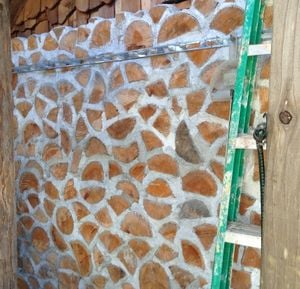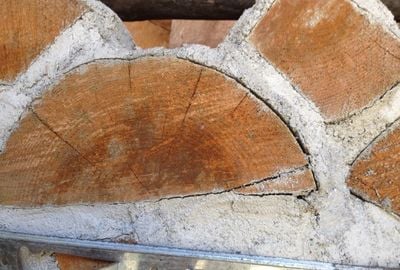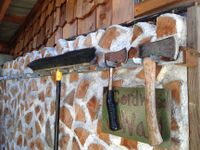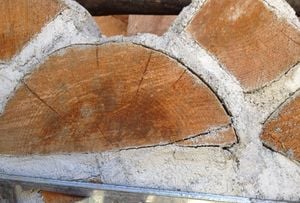
This is the Operation and Maintenance (O&M) manual for CCAT greenshed cordwood wall. Please refer to it and keep it up to date with any O&M changes.
Summary[edit | edit source]
The CCAT cordwood wall was constructed using primarily cedar logs and cement mortar. While mortars are very rigid and static once they are set, cordwood tends to change shape, shrinking as it dries. This may cause the wood to separate from the mortar leaving gaps as well as cracks in the wood. Such cracks are not typically an indication of a structural issue. They are at most an aesthetic nuisance. The following section outlines an optional remedy for minor cracks.
Maintenance[edit | edit source]
- Cordwood walls are generally very durable and structurally sound. It is generally safe to drill into the wood to hang most types of tools from the walls.
- Small amounts of shrinkage causing gaps should not cause any significant problems. If the gaps between the cordwood and the mortar continue to expand, a "chinking compound" may be applied to prevent air infiltration. The following is an example of a simple mixture. Other options are available and can be found online.
- 2 parts clay
- 1 part sifted wood ashes
- ½ part granulated salt
- Water to mix
We measured the ingredients out with a big bucket and mixed each batch of chinking in a wheelbarrow with a small garden spade. If you try our formula, remember that the water should be added slowly, until you can "feel" the mass sticking together. A little experimenting is needed to get the hang of this part of the job: Make your mix too dry and you won't be able to spread it... too wet and it'll drip all over. The actual chinking is slow and steady work and we learned to do it when we had lots of time (a batch every few days on and off, preferably when the weather was on our side). It's not much fun to stand out there with the winter winds beating on your back and, according to Bradford Angier, chinking shouldn't be done during a cold spell anyway because frost will expand the moisture in the filler and force the mortar out of the cracks. Our cabin is fairly large — 22 by 28 feet — and plugging all the crannies was a big job. Once you get the knack, though, it's possible to cover about 10 to 20 running feet per hour. We applied the mixture with a wide-bladed putty knife, since the spaces between our building's logs are quite large. Charlie Madson suggests a garden trowel. A small putty knife — or even a kitchen spatula — would work as well, though, depending on the size of the gaps. Whatever tool you choose, insert the chinking into the cracks as far as need be. Then, if there's still a hole to fill, apply more of the compound and smooth the surface with the flat of the blade. Any droppings on the logs may be wiped off with water and an old rag. Certain conditions of climate and temperature may cause the mortar to crack as it begins to harden. If that happens, go over the chinking every week or so with your putty knife and some water until the damaged areas are once again smooth and stay smoothed. Read more: http://www.motherearthnews.com/diy/log-cabin-chinking-zmaz75ndzgoe.aspx#ixzz2zXyNsCXp

Schedule[edit | edit source]
- Monthly
- Check for any major cracks or gaps that are letting air through. Apply chinking compound if needed.
- Yearly
- Check for any major cracks or gaps that are letting air through. Apply chinking compound if needed.
Instructions[edit | edit source]
Prepare the chinking compound
Apply the chinking compound to individual cracks with a spatula, or apply to entire mortar area with a trowel or spatula

